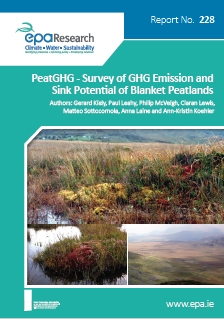Authors: Gerard Kiely, Paul Leahy, Philip McVeigh, Ciaran Lewis, Matteo Sottocornola, Anna Laine and Ann-Kristin Koehler
Summary: Pristine peatlands are mostly sinks for carbon, while harvested or cut-away peatlands are sources of carbon. The principal pressures on Irish peatlands are associated with anthropogenic activities over the past few hundred years.

Pristine peatlands are mostly sinks for carbon, while harvested or cut-away peatlands are sources of carbon. The principal pressures on Irish peatlands are associated with anthropogenic activities over the past few hundred years, namely:
Such activities have lowered the water table and cut away peat depth to several metres in places, leaving exposed peat and non-vegetative land surfaces. In the coming decade, these activities will decrease due to the end of Bord na Móna’s use of peat for electricity generation. However, this will leave extensive areas with degraded peat surfaces. The key challenge now is how to manage these degraded peatlands sustainably (in a carbon-neutral way) and to preserve the remaining pristine peatlands in the face of the continued pressure from anthropogenic climate change.
This project has quantified that a near-pristine blanket peatland in Glencar, County Kerry is a net sink for carbon for most years of the decade long field experiment. On the other hand, based on literature reviews, degraded or cut-away peatlands are net sources of carbon emissions. This suggests that the remaining pristine peatlands in Ireland should be conserved as carbon sinks, while degraded peatlands need to be examined further to identify sustainable management strategies into the future.
Suggested solutions include conserving the remaining pristine and near-pristine peatlands and protecting peatland margins to maintain hydrological integrity. This will enable this land cover to remain as a sink for carbon into the future. Although it is expected that this sink may reduce under climate change. Management options at cut-away and degraded peatlands need to be examined to minimise carbon losses. Possible management strategies include allowing the water table to be raised to encourage the revegetation or to allow its natural colonisation with tree species such as birch. This is occurring in several areas across Ireland. However, the carbon sink strength of such “new land cover” remains to be determined.
https://www.epa.ie/media/epa-2020/publications/research/Research_228_thumnail[1].jpg